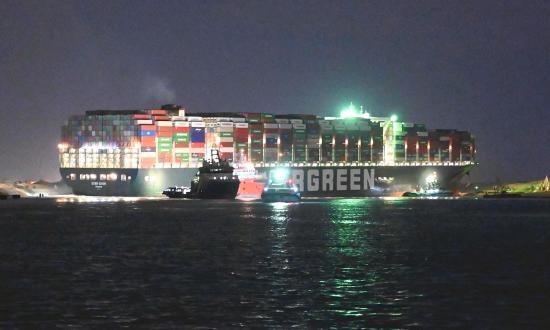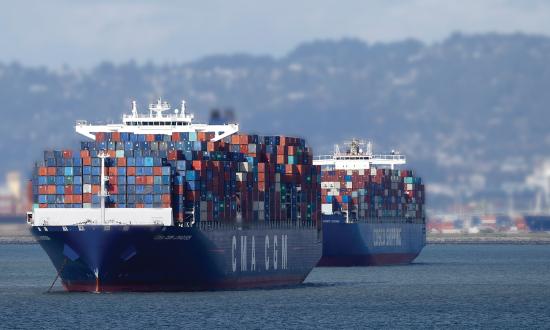The free flow of international maritime commerce is critical to the national and economic security of the United States and its allies. Nowhere is this more true than in the three major maritime chokepoints in the Middle East region—the Gulf of Hormuz, the Suez Canal, and the Strait of Bab el-Mandeb—through which one-sixth of the world’s oil and a third of its liquefied natural gas production transits.
From unmanned vessel attacks to limpet mines to the recent seizure of the M/T Hankuk Chami by the Iranian Navy, numerous threats continue to attempt to destabilize commercial shipping. The COVID-19 pandemic has only made life and business even more challenging.
It is clear that one entity, alone, cannot provide assurance to merchant shipping in this region. Never before has it been more important to collaborate with coalition partners and stakeholders to protect freedom of navigation in this critical part of the world. This is the mission of NCAGS.
NCAGS
Naval Cooperation and Guidance for Shipping (NCAGS) bridges the gap between forward-deployed military forces and merchant shipping by providing a framework for communicating directions, advisories, concerns, and information within a maritime region. It assists the fleet commander in managing risk by providing situational maritime domain awareness and real-time clarity of the merchant shipping picture and helps ensure the safe passage of merchant shipping in a crisis or contingency. As a component of maritime strategy, NCAGS can provide U.S. and allied merchant vessels the information needed to avert malign activities, at sea or in port, or events that may have a negative impact on security, safety, the economy, and the environment.
The NCAGS team is scalable—from a single merchant marine advisor to a large theater contingent complete with a shipping coordination center, shipping coordination teams assigned afloat (or in regional seaports), and liaison officers at supported commands or embarked on board coalition warships or merchant vessels. It works in close coordination with NATO and other ally partners that have an NCAGS equivalent, also known as maritime trade operations (MTO). In 2001, the United Kingdom established a small MTO office in Dubai to look after British merchant vessels in the wake of the 11 September attacks. In accordance with NATO doctrine, UKMTO established a voluntary reporting area, a high-risk area, and detailed reporting procedures that remain in effect today and are supported by the maritime industry.
The NCAGS battle watch is made up entirely of U.S. Navy reservists, many of whom are professional merchant mariners or strategic sealift officers who leverage their civilian expertise and experience when they report for active duty. These reservists, both officer and enlisted, are the force multipliers within the NCAGS mission and the machine providing continued support to merchant shipping. NCAGS activities include:
• Providing situational awareness regarding vessels/ports of interest
• Creating vessel incident reports
• Offering guidance on maritime domain awareness and pattern of life trends
• Conducting ship visits (currently on hold because of COVID-19)
• Interpreting/recommending trade routes through heat maps
• Providing Merchant Marine subject matter expertise, both deck and engineering
• Supporting command task forces throughout U.S. Naval Forces Central Command
NCAGS Operations
The NCAGS battle watch is continuously manned and maintained. Within the first 96 hours prior to the arrival of a U.S. vessel in the area of responsibility, the battle watch will notify the vessel and transmit a welcome aboard email. Just inside of 24 hours prior to arrival, the vessel is required to submit an initial report using the fifth edition of Best Management Practices to Deter Piracy and Enhance Maritime Security in the Red Sea, Gulf of Aden, Indian Ocean and Arabian Sea (BMP5) and UKMTO formats. Generally, most vessels transiting the region are familiar with what is required. The team typically establishes touchpoints with merchant shipping, such as the high-risk area defined by UKMTO at the 15-degree north latitude in the southern Red Sea, provides daily situation reports to vessels while in the region, and offers guidance through the Strait of Hormuz transit.
The most current information and an accurate assessment of the merchant shipping picture are critical to establishing the pattern of life and achieving maritime domain awareness. Masters are asked to provide basic information concerning their ships, cargoes, and voyages. In times of increased tension or conflict, additional information may be requested. The commercial sensitivity of the information supplied is always respected and protected.
Response from a master to information requests is one of the most important aspects of NCAGS. During the recent M/S Ever Given grounding in the Suez, the container ship Maersk Denver was astern of the Ever Given providing photos and onsite coverage of salvage team efforts to free the vessel from the east bank. This onsite provision of invaluable information assisted greatly with shaping the pattern of life of merchant traffic rapidly blocking the north and south canal entry points.
The NCAGS team ensures the appropriate military authorities are advised of a vessel’s details for monitoring during the voyage. If deemed necessary, watchstanders will provide the merchant master with up-to-date information on the situation and specific information on the voyage. This information can range from basic situation briefs to the provision of routes, lead through, or escort. Ultimately, responsibility for safe passage remains with the master.
The NCAGS office has a full suite of monitoring and tracking capabilities, which maximizes operational efficiency. Staying up with the latest in information technology will keep the team ahead of U.S. adversaries and reduce risk as it relates to operations, monitoring and surveillance, piracy, war, or other threats to maritime domain awareness and pattern of life within the region.
Coalitions & Stakeholders
As the world has battled the pandemic, the NCAGS team has had to find creative ways to work smarter and communicate more. Incorporating new methods of engaging with stakeholders and coalition partners has been critical to the overall success of NCAGS. Stakeholder and coalition involvement guarantees the team is monitoring international and economic interests and ensures doctrine is implemented successfully.
All NCAGS partners have the same desired end state: a secure maritime environment and safe transit. Given the high risk of navigating in the Middle East, stakeholder involvement and information sharing has seen a steady uptick. Stakeholders and coalition partners possess and have shared specific knowledge and expertise that is paramount in staying ahead of adversaries in the region. Using this wealth of knowledge increases the quality of products delivered to Naval Forces Central Command leaders.
Another key ingredient is memorandums of understanding that firmly and properly align NCAGS’s monitoring and tracking of merchant shipping traffic in the region. With stakeholders and coalition partners’ amplified support of crucial waterways and strategic chokepoints, the NCAGS team has broadened its ability to communicate while remaining focused on ensuring safe navigation in the Middle East region.
Solid relationships with stakeholders and coalition partners are critical in keeping us ahead of our adversaries. As Rear Admiral Lee Metcalf noted:
Our Nation’s maritime interests are best served by working together across the globe with many partner nations to foster security and cooperation. NCAGS is a key resource in building to that end state; building maritime domain awareness through collaboration and common technologies.
Regional stability is intricately tied to maritime security. Collaborating with the global maritime communities of interest (allies, partners, industry), we not only can provide greater situational awareness of the maritime domain to the commander, but also can create a thousand-ship navy by fostering trusted relationships, active communication, and information sharing.







